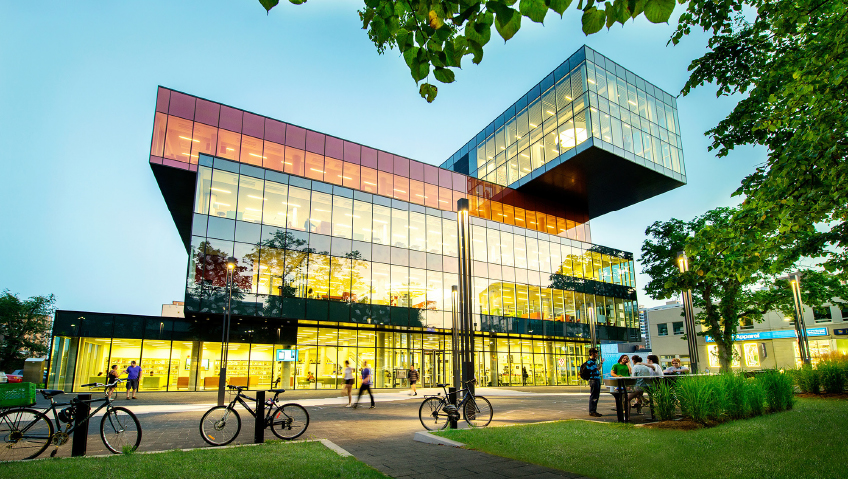Since 2017, the Truro & Colchester Partnership for Economic Prosperity (TCPEP) has been driving economic development in the centrally located Colchester region of Nova Scotia.
With the purpose of helping businesses start, grow, overcome challenges, and create opportunities, TCPEP is a partnership of the local business community, municipalities and the Province. This includes the towns of Truro (TCPEP’s base) and Stewiacke; the Municipality of Colchester County, from Tatamagouche on the Northumberland Strait to Great Village on the Bay of Fundy; Millbrook First Nation; and the Government of Nova Scotia.
When not abbreviated, TCPEP is indeed a long name, CEO David Phillips admits, “but it focuses on our goal to improve and expand economic prosperity throughout the region.”
TCPEP is one of seven Regional Enterprise Networks in Nova Scotia that are showing that a collaborative approach to economic development can support business growth and attract investors across Nova Scotia.
Networks receive funding from local municipalities, from the provincial government, and in the case of TCPEP, from such local businesses as Asante Logistic Group. Inc., Casey Concrete, G&G Computers, and Will-Kare Paving—support from the business community that Phillips says makes TCPEP unique.
In addition, TCPEP works with several business funding partners, including the federally funded Atlantic Canadian Opportunities Agency, Invest Nova Scotia, banks, and credit unions. Its service model, focused on business, helps established businesses and entrepreneurs to navigate the many funding options available to entrepreneurs.
“We’ll help them build a business plan and provide all the information they need to secure funding,” Phillips says.
There are many reasons that established businesses, entrepreneurs, investors, and workers are drawn to the region. Chief among them is its strategic central location, which, with a population of over one million people within a radius of 150 kilometres, is unique in Atlantic Canada. Not even HRM or Moncton can boast such easy access to so many people.
Truro, referred to as the Hub of Nova Scotia, sits at the intersection of the province’s two main highways. Highway 104, part of the Trans Canada Highway connecting Nova Scotia with the rest of the country, runs west to east from Amherst on the New Brunswick border to Cape Breton Island, with ferry connections from North Sydney to Newfoundland.
Nova Scotia Route 102 runs south to connect with the Robert Stanfield International Airport and leads to the Halifax Regional Municipality (HRM), Atlantic Canada’s largest urban centre, and the Port of Halifax. Route 102 also has access ramps to the Annapolis Valley and South Shore. Forget Rome, in Nova Scotia all roads lead to Truro.
Truro is also at the centre of the rail corridor that connects HRM and the Port of Halifax to the rest of Canada. All of the province’s other rail lines have been converted to hiking trails; however, this one essential CN freight line remains fully operational, and Phillips is optimistic that it will eventually be reconnected to the port in Cape Breton. VIA Rail, a passenger service, also operates on the Halifax to Moncton route and stops in Truro. With climate concerns and the efficient movement of goods moving to the forefront of our priorities, commercial rail is expected to make a significant comeback.
Debert Industrial Park, adjacent to Truro, has one working runway, with space for two more, and the ability to accommodate commercial aircraft services.
“As a consequence of the Port of Halifax, the largest in eastern Canada, running out of storage space, there’s the possibility to create an inland port in the Debert area where overflow from Halifax as well as from the port in Cape Breton could be stored before being shipped by rail, road, or air to the rest of the country. Alternatively, goods from the rest of Canada could be stored in Debert awaiting shipment via the ports,” Phillips says.
A prime example of how well Debert’s location works as a warehouse and distribution centre is Home Hardware’s Eastern Distribution Centre. It’s a 600,000 square foot facility with between 250 and 280 employees, capable of handling 52 million pieces of hardware, lumber, building materials and furniture. It’s one of the four distribution centres that serve over 11,000 Home Hardware outlets across Canada.
Commenting on the location, Phil Smith, Assistant Manager, says, “Debert was chosen because Truro-Colchester is a hub. It’s central for us because it allows us to get products to our stores in Atlantic Canada and parts of Quebec.”
The Debert Industrial Park is just one of six industrial and business parks in the region, with others in Truro, Millbrook and Stewiacke, all of which house a variety of businesses.
“We have a long history as a transportation, distribution, and logistics hub and we keep building on it,” Phillips says, “but we also have a long history in agriculture which was important here once, and will be again, as food security has become an important issue. We have a strong history in manufacturing with companies like Stanfield’s and Intertape Polymer, and we have a lot of hard-working and innovative people.”
While those companies continue to thrive, there are other exciting and innovative developments.
One is the research and development facility of TruLeaf Sustainable Agriculture in Bible Hill, just outside Truro, which is dedicated to proving that indoor-hydroponic farming is a commercially viable way to provide Canadians with fresh, nutritious produce year-round.
After showing that this method was indeed viable by providing Colchester retailers and restaurants with greens, the company opened a facility ten times larger in Guelph, ON, and is now turning its original facility into a world-class research space.
Because of its proximity to Dalhousie University’s Agricultural Campus in Bible Hill and the Truro branch of the Nova Scotia Community College, where students receive engineering and mechanical training, it can draw on the knowledge and expertise these institutions provide.
Says Jeff McKinnon, TruLeaf Sustainable Agriculture’s Senior Vice President, Network Development, “We have the mindset of really scaling up this business and building automated farms all over the world, and we want that research to be based in Bible Hill.”
Another success story is Ocean Sonics, which designs and builds innovative products to improve the quality and success of underwater sound measurements and ships its products all over the world. It was originally in Great Village, a rural community 25 miles from Truro, chosen because products could be tested in the waters of the Bay of Fundy.
When Ocean Sonics outgrew its facility, an architect was hired to design a bright, modern, light-filled facility, six times the size of the original, with a “room-within-a-room” specifically designed to properly test underwater sound equipment.
This new facility is in the Bayview Business Park in Truro Heights, directly off Route 102, an easy drive to the international airport or HRM to ship finished products.
For all of us, finding a work/life balance is key to both personal happiness and business success. The two complement each other and that balance is something the Truro and Colchester area offers its residents in generous quantities.
Living in the Colchester region means no long commutes to work, no traffic congestion, no smog. Opportunities for outdoor rest and relaxation abound, from the Northumberland Strait beaches with the warmest waters north of the Carolinas to the Bay of Fundy shore and the Cliffs of Fundy Geo Park, which has been declared a UNESCO Geological Site, to the over 2000-acre wooded Victoria Park, a gem right in the heart of Truro.
There are golf courses throughout the region and a brand-new community centre which includes a stadium, home to a major junior hockey league team, a gym, and a pool.
Colchester is served by a modern regional hospital in Truro; has excellent public schools and public library facilities.
We asked why Phillips chose to return to his hometown of Truro, following a 32-year international marketing career with Microsoft and the Moët Hennessy Louis Vuitton (MHLV) Group, luxury conglomerate of the world.
After five years in Toronto with Microsoft he left Canada, moved to Paris as group manager of Microsoft intelligence for Europe, Africa and the Middle East, and later took on the role of worldwide field intelligence lead. So why come back?
“Family and friends,” he says. “I’m a typical Maritimer and I wanted to come home and round out my career doing something for my community.” He admits, however, that if Truro was still what it was when he left in the late 1980s, he might not have returned.
“Over the last 20 years, Truro has come into its own as a vibrant, fast-growing community, with lots of great shops, restaurants, and things to do. It’s much more diverse and welcoming than when I was growing up. It’s a younger town than it used to be, and it’s exciting, energetic, and fun. At the same time, it has maintained its graciousness and beauty. It’s a lovely place to live.”
Launched at the end of September was the Truro & Colchester Welcome Network, a TCPEP initiative that Phillips describes as a “welcome wagon on steroids.”
“It’ll be a volunteer organization that spans the region and welcomes newcomers, whether they’re from just down the road or another country, so we can help them make a soft landing. We want to integrate them into the community, make them feel welcome, supported, and valued because we’re excited about people coming to this region. We also have a connector service which connects skilled workers with employers,” Phillips explains.
“One of the good things [coming out of] COVID,” he says, “is that people have realized they can live and work anywhere. We have people who have relocated here and are working for Google, for example. The idea that you can live in a safe, beautiful, vibrant community, with excellent schools, and close to the ocean, while doing the same job you did in Toronto or New York, is compelling.”
He cites examples of people who have sold one house in Toronto or Ottawa, and were able to build a new home, a cottage, and an income property. “With the average home price around $300 000, you can buy a beautiful home and still have money in the bank. An added benefit is that the cost of living is lower here.”
Aside from the digital nomads, Phillips says TCPEP would like to attract more young people and more skilled workers, from tradespeople such as electricians, mechanics, carpenters, and welders, to engineers, software architects, and, as in most regions across Canada, more doctors, nurses, and health care professionals.
He’s also hoping to attract more entrepreneurs and people interested in opening a restaurant or shop to service the growing population, as well as business start-ups that are complementary to ones already in place so they can share ideas and synergies or fit in the supply chain.
“There is still a lot of work to do, and it wouldn’t be as exciting a job if everything were working perfectly, but there is such a great foundation to build on, and such a lot of accomplishments to come, that I’m looking forward to being a part of it.”






